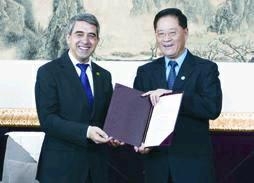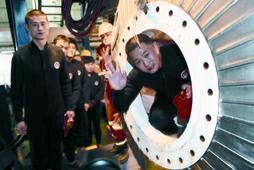Wetland Coverage
2014-02-17
China has a total of 53.6 million hectares of wetlands, accounting for 5.58 percent of its territory area, according to survey figures released by the State Forestry Administration on January 13.
The survey was conducted between 2009 and 2013 to facilitate the countrys wetland protection.
Total acreage of wetlands dropped 8.82 percent from a previous survey that ended in 2003.
Natural wetlands covered an area of 46.67 million hectares, or 87.08 percent of the total area of wetlands.
Lunar Exploration
Chinas moon rover Yutu, or Jade Rabbit, completed its first scientific exploration of lunar soil on January 14, according to the Beijing Aerospace Control Center (BACC).
The rover used its mechanical arm to carry out the survey, following instructions from the control center, according to a BACC statement.
“Accurate direction of the mechanical arm from a distance of 380,000 km has been realized, a breakthrough for China in achieving long-distance remote control,” said Wu Fenglei of the BACC.
Chinas Change-3 lunar probe, which launched from Earth with Yutu onboard, soft-landed on the moon at Sinus Iridium, or the Bay of Rainbows, on December 14 last year. After landing, the rover separated from the Change-3 lander.
The rover and lander entered a period of dormancy that lasted two weeks, the same as one lunar night, on December 26, 2013, in a move designed to ride out the moons harsh climactic conditions. They awakened autonomously on January 12.
Tough on Graft
The Communist Party of Chinas disciplinary watchdog closed graft investigations into eight high-profile officials and handed over their cases to prosecutors in 2013, a senior discipline inspector revealed on January 10.
The officials were Zhou Zhenhong, Liu Tienan, Ni Fake, Wang Suyi, Li Daqiu, Tong Mingqian, Yang Kun and Qi Pingjing, said Huang Shuxian, Deputy Secretary of the Partys Central Commission for Discipline Inspection (CCDI) and Minister of Supervision, at a press conference.
Five of the eight officials previously held provincial-level positions, two were senior officials of central government departments while one was senior executive of a state bank. The cases were only a few among the 31 high-profile officials investigated by the CCDI last year, with the remaining 23 still under investigation, including Jiang Jiemin, former head of the Stateowned Assets Supervision and Administration Commission of the State Council, and Li Dongsheng, former Vice Minister of Public Security, Huang added.endprint
Last year, the Partys discipline inspection agencies punished about 182,000 officials nationwide, 13.3 percent more than in 2012, according to Huang.
Among them, about 150,000 were subject to Party discipline punishment and 48,900 were subject to administrative punishment.
Tibetan Education
Tibetans receive 8.4 years of education on average, according to data released by education authorities of Tibet Autonomous Region on January 14.
The data also showed that primary school enrollment rates in the region reached 99.59 percent in 2013.
In 2013, the regional government invested 11 billion yuan ($1.82 billion) in education, benefiting 600,200 enrolled students, according to Ma Shengchang, director of the regional education department.
Ma added that Tibet was the first place in China to provide nineyear compulsory education for free,back in 2007, and it was the first to provide 15-year education for free when it started doing so in 2012.
The regional government also plans to increase the annual budget for the educational subsidy scheme by 70.5 million yuan ($11.65 million) from September.
In the coming semester beginning in fall, children at a kindergarten through to a senior high level will receive 2,900 yuan($479) each to help cover annual expenses for food, accommodation and educational supplies while they attend boarding school, according to Lu Mingxiu, an official with the Tibet Bureau of Finance.
Top Prize
Following a three-year vacancy, the top natural science prize at Chinas annual national science awards was given for the discovery and research of iron-based compounds that can be used as high-temperature super- conductors on January 10.
Superconductivity refers to a phenomenon where electrons travel with no resistance when a conducting material, known as a superconductor, is cooled below a certain temperature.
With a range of cutting-edge technological applications, superconductivity has become a part of daily life, from boosting cell phone signals to offering medical imaging.
At the award ceremony, leading project contributors, including Zhao Zhongxian and Chen Xianhui, received the 200,000-yuan($33,040) prize on behalf of their research team with the Institute of Physics under the Chinese Academy of Sciences and the University of Science and Technology.
Most superconductors only work at temperatures close to 0 K, or 273.15 degrees Celsius below zero—the lowest temperature possible, known as absolute zero.endprint
The discovery marked a new“family” of iron-based superconducting materials that lift the highest temperature for resistance-free flow to 55 K, Chen said.
Blast Investigation
Chinas top work safety watchdog unveiled a full investigation report on January 11 regarding a fatal pipeline blast that claimed 62 lives in the eastern city of Qingdao, Shandong Province, on November 22, 2013.
The primary cause of the accident was that drilling operation by repair staff produced sparks that led to an explosion fuelled by oil leaked from a pipeline owned by a subsidiary of Sinopec, the countrys largest oil refiner, according to the report compiled by a special investigation group set up by the State Council, Chinas cabinet.
The blast also injured another 136 people and caused a direct economic loss of 752 million yuan($124 million), the report revealed.
A total of 63 people will be penalized, with 48 of them to receive punishments for violating Party and administrative disciplines and 15 others being transferred to judicial bodies for further judgment on their alleged crimes, the report added.
Desalinated Sea Ice
China will soon begin production of large amounts of fresh water through the desalination of sea ice, according to a Beijing Normal University research team and Beijing Huahaideyuan Technology Co. Ltd. The two organizations signed a technology transfer agreement on January 14.
The company is expected to be able to produce at least 1 billion cubic meters of fresh water annually by 2023, according to Yu Jian, Executive President of Huahaideyuan.
Chinas sea ice desalination program started in 1996 and has received a total of 29.7 million yuan ($4.88 million) in funding from various government departments since then.
Sea Mission
A diver enters a diving bell to get ready for a 300-meter saturation dive under the South China Sea on January 9.
China succeeded in its first 300-meter saturation dive on the morning of January 12 as three divers returned safely to the living chamber on their ship.
The diving bell reached a depth of 313.5 meters under sea surface. Saturation diving enables human beings to avoid the dangers of decompression sickness by being kept in an artificially high-pressure environment for longer periods of time.endprint
Power Connection
A worker from a grid company checks a power transmission tower in Zhoushan, Zhejiang Province, on January 15.
This is the first 500-kv cross-sea power transmission line in China.
Probe Continues
Chinas anti-trust probe against Swedish firm Tetra Pak has not stopped, the State Administration for Industry and Commerce (SAIC) said on January 15.
The investigation of the food processing and packaging companys possible abuse of market dominance is still underway, a SAIC spokesman said at a press conference.
Finance.ifeng.com, a Hong Kong media outlet, reported earlier that the SAIC had stopped the probe of Tetra Pak two months after the investigation began with little progress made.
In July, the SAIC enlisted more than 20 provincial and municipal industry and commerce agencies to look into Tetra Pak, and the probe made progress in December, according to Zhang Mao, SAIC Director.
Tetra Pak, which entered China in 1979, has a research and development center in Shanghai and packaging facilities in four Chinese cities, including Beijing. The company processes and packages liquid dairy products as well as other beverages.
Lending Moderated
New data has shown that Chinas lending in 2013 was moderated and the growth of broad money supply eased, triggering forecasts that credit tapering will continue in 2014.
Chinas new yuan-denominated lending stood at 8.89 trillion yuan($1.5 trillion) in 2013, up 687.9 billion yuan ($113.6 billion) from the previous year, said Sheng Songcheng, head of the Statistics Department at the Peoples Bank of China, the countrys central bank, on January 15.
Total social financing, a measure of funds raised by entities in the real economy and a broad measure of liquidity in the economy, hit a record high of 17.29 trillion yuan($2.9 trillion) last year, up 1.53 trillion yuan ($252.8 billion) year on year.
New yuan lending accounted for about 51.4 percent of total social financing, the lowest proportion in history and 0.6 percentage points lower than 2012.
The narrow measure of money supply (M1), which covers cash in circulation plus current corporate deposits, rose 9.3 percent from the year earlier period to 33.73 trillion yuan ($5.6 trillion).
The broad measure of money supply (M2), which covers cash in circulation and all deposits, jumped 13.6 percent to 110.65 trillion yuan($18.3 trillion) in 2013, 0.2 percentage points less than in 2012, Sheng said.endprint
Outstanding cash in circulation(M0) amounted to 5.86 trillion yuan ($968.1 billion), up 7.1 percent from 2012.
“The moderation in M2 and credit growth is in line with our view that credit tapering will continue in 2014,” said Zhu Haibin, J.P. Morgan China Chief Economist.
Sheng said 2014 will see the central bank continue to implement a prudent monetary policy, make appropriate preemptive adjustments, and use various liquidity management tools to make monetary conditions“not too tight nor too loose.”
China has kept a proactive fiscal policy since late 2008, when the country unveiled a 4-trillion-yuan($566 billion) stimulus package to cushion the impact of the global financial crisis. Its monetary policy has been prudent since late 2010.
New Gas Field
The China National Offshore Oil Corp. Ltd., the countrys largest offshore oil producer, announced on January 14 the operation of the Liuhua 19-5 Gas Field.
The gas field is expected to hit its peak production of 29 million cubic feet per day within the year, a company press release said.
The project is located in the Pearl River Estuary Basin of the South China Sea with an average water depth of about 185 meters.
It was designed to share the existing production facilities of the Panyu 30-1 Gas Field. Two new producing wells have also been drilled.
Nuclear Project
The Ningde Nuclear Power Station in east Chinas Fujian Province will double its generation capacity in 2014 as its second generating unit is expected to be put into commercial use in the first half of this year, a company source said on January 15.
The second generating unit, which has an installed capacity of 1.09 million kw, went into operation on January 4, according to a press conference held by the Fujian Ningde Nuclear Power Co. Ltd., the operator of the plant.
The first generating unit went into operation in April 2013. It produced about 7 billion kwh of electricity last year.
The two generators will produce 12.5 billion kwh of electricity in 2014, accounting for 7.26 percent of the provinces electricity consumption in 2013.
After its third and fourth generating units, which also have installed capacity of 1.09 million kw each, become operational next year, the power plant is expected to produce 30 billion kwh of electricity annually.
Compared with a similar coal-fired plant, the four nuclear generators can reduce coal consumption by 9.8 million tons of coal a year. They can also help cut carbon dioxide emissions by 24 million tons per year and sulfur dioxide emissions by 230,000 tons.endprint
China currently has 17 nuclear reactors in operation, as well as 28 more under construction that account for two fifths of unfinished reactors throughout the world.
Hybrid Trains
The China CNR Corp. Ltd. (CNR), one of the countrys largest train makers, announced on January 14 that it would roll out a prototype of a hybrid high-speed train off the production line in September 2015.
Changchun Railway Vehicle Co. Ltd., a subsidiary of the CNR, will integrate two or three power sources—electricity, battery pack or diesel engine—into the new model, according to the CNR.
The power sources will form twoin-one or three-in-one power packs depending on operational and rail conditions. The design speed of the new model will be 160 km per hour. It is expected to run on both trunk and branch railways, said the CNR.
They will be widely used compared with traditional trains because of their adaptability to travel on both electric and nonelectric railways.
By the end of 2013, 52.4 percent of Chinas railways had been electric. This will increase, according to the countrys medium- and long-term railway development plan.
The production of hybrid highspeed trains will serve the countrys increasing number of electric railways, according to the CNR.
Hi-Tech Plantation
A farmer walks in a greenhouse in the Huasheng Solar Power Farm in Jimo, east Chinas Shandong Province, on January 15.
The solar panels installed on the roof can adjust lighting and temperature in the greenhouse. endprint
endprint
